 |
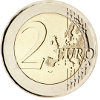 |
C o m m e m o r a t i v e
C o i n s |
||
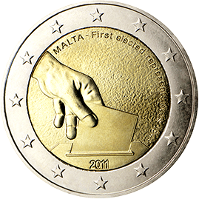 🔎
🔎 |
 |
Malta | 17 Oct. 2011 | First election of representatives in 1849 1st coin of the Constitutional History series |
20001 20002 20005 |
405,000 |  |
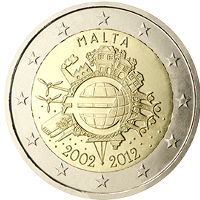 🔎
🔎 |
 |
Malta | 30 Mar. 2012 | 10th anniversary of the Euro‐Currency |
20001 20002 20005 |
500,000 |  |
National characteristics : At the top of the coin is the name of the issuing country "MALTA". The coin was minted without a mint mark by the Royal Dutch mint Koninklijke Nederlandse Munt in Utrecht. |
|||||||
 🔎
🔎 |
 |
Malta | 20 Aug. 2012 | 1887 Majority Representation 2nd coin of the Constitutional History series |
20001 20002 20005 |
405,000 |  |
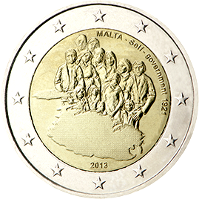 🔎
🔎 |
 |
Malta | 24 Jun. 2013 | Establishment of Self‐Government in 1921 3rd coin of the Constitutional History series |
20001 20002 20005 |
542,500 |  |
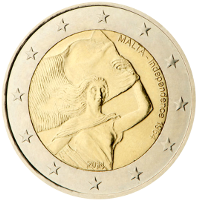 🔎
🔎 |
 |
Malta | 03 Jun. 2014 | Independence from Great Britain in 1964 4th coin of the Constitutional History series |
20001 20002 20005 |
432,500 |  |
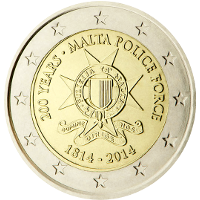 🔎
🔎 |
 |
Malta | 16 Jul. 2014 | 200th anniversary of the Malta Police Force |
20001 20002 20005 |
300,000 |  |
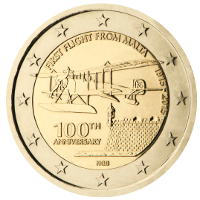 🔎
🔎 |
 |
Malta | 25 May 2015 | 100th anniversary of the first flight from Malta |
20001 20002 20005 |
325,000 |  |
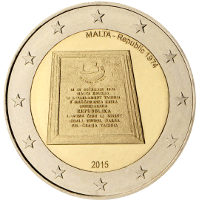 🔎
🔎 |
 |
Malta | 23 Jun. 2015 | Proclamation of the Republic of Malta in 1974 5th coin of the Constitutional History series |
20001 20002 20005 |
435,000 |  |
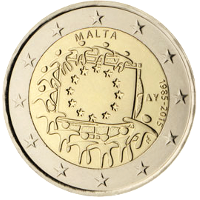 🔎
🔎 |
 |
Malta | 18 Dec. 2015 | 30th anniversary of the EU‐Flag |
20001 20002 20005 |
300,000 |  |
National characteristics : Above is the name of the issuing country "MALTA", followed by the dates "1985‐2015". On the right the sails of the three‐mast clipper Nederland the logo of the mint master Maarten Brouwer, and the staff of Hermes the mint mark of the Royal Dutch mint Koninklijke Nederlandske Munt in Utrecht. |
|||||||
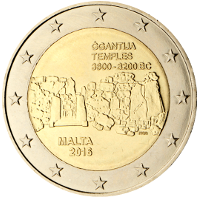 🔎
🔎 |
 |
Malta | 22 Aug. 2016 | Ġgantija Temples 1st coin of the Maltese Prehistoric Sites series |
20001 20002 20005 |
410,000 |  |
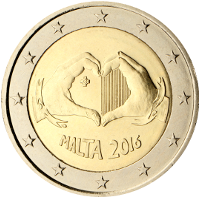 🔎
🔎 |
 |
Malta | 05 Dec. 2016 | Solidarity through Love 1st coin of the from children in solidarity series |
20001 20002 20005 |
380,000 |  |
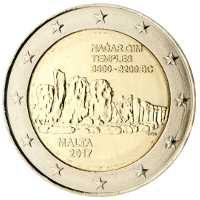 🔎
🔎 |
 |
Malta | 31 May 2017 | Tempel of Ħaġar Qim 2nd coin of the Maltese Prehistoric Sites series |
20001 20002 20005 |
405,000 |  |
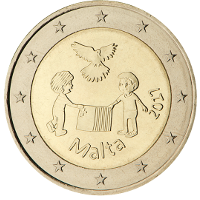 🔎
🔎 |
 |
Malta | 13 Nov. 2017 | Solidarity and Peace 2nd coin of the from children in solidarity series |
20001 20002 20005 |
380,000 |  |
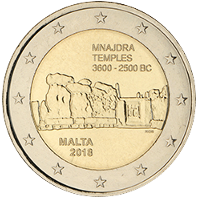 🔎
🔎 |
 |
Malta | 21 Jun. 2018 | Mnajdra Temples 3rd coin of the Maltese Prehistoric Sites series |
20001 20002 20005 |
335,000 |  |
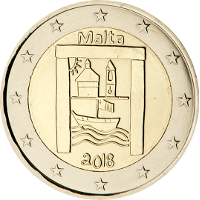 🔎
🔎 |
 |
Malta | 07 Nov. 2018 | Cultural heritage 3rd coin of the from children in solidarity series |
20001 20002 20005 |
320,000 |  |
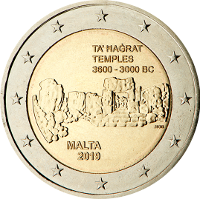 🔎
🔎 |
 |
Malta | 13 May 2019 | Ta' Ħagrat Temples 4th coin of the Maltese Prehistoric Sites series |
20001 20002 20005 |
335,000 |  |
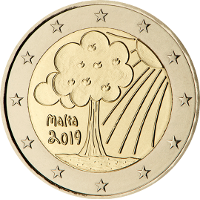 🔎
🔎 |
 |
Malta | 21 Oct. 2019 | Nature and Envirement 4th coin of the from children in solidarity series |
20001 20002 20005 |
320,000 |  |
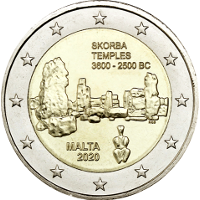 🔎
🔎 |
 |
Malta | 24 Jul. 2020 | Skorba Temples 5th coin of the Maltese Prehistoric Sites series |
20002 20007 20008 |
200,000 |  |
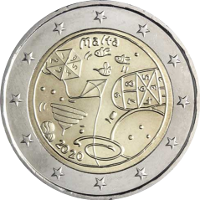 🔎
🔎 |
 |
Malta | 11 Dec. 2020 | Games 5th coin of the from children in solidarity series |
20002 20007 20008 |
220,000 |  |
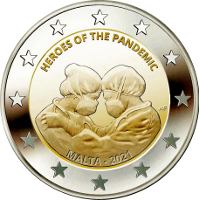 🔎
🔎 |
 |
Malta | 02 Aug. 2021 | Heroes of the Pandamic |
20002 20003 20005 |
72,500 |  |
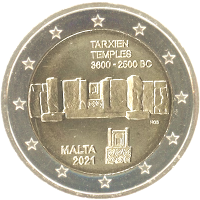 🔎
🔎 |
 |
Malta | 26 Oct. 2021 | Tarxien Temples 6th coin of the Maltese Prehistoric Sites series |
20002 20007 20008 |
181,000 |  |
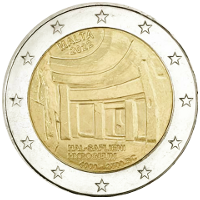 🔎
🔎 |
 |
Malta | 17 Nov. 2022 | Hypogeum of Ħal‐Saflieni 7th coin of the Maltese Prehistoric Sites series |
20003 20005 20009 |
180,000 |  |
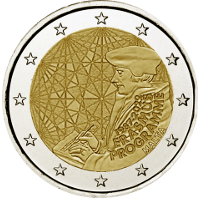 🔎
🔎 |
 |
Malta | 17 Nov. 2022 | 35th anniversary of the Erasmus Program |
20003 20005 20009 |
82,500 |  |
National characteristics : The quarter circle at the bottom right has four lines; below the commemorative period the occasion of issue "ERASMUS PROGRAMME" is written in two lines, below it the issuing country "Malta" is centred. The coin was produced without mint mark by the Dutch mint Koninklijke Nederlandse Munt in Houten. The coin belongs to those with a more structured background. |
|||||||
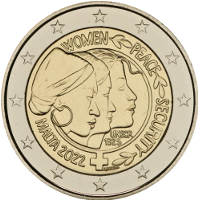 🔎
🔎 |
 |
Malta | 17 Nov. 2022 | United Nations Security Council Resolution on Women Peace and Security |
20003 20005 20009 |
53,000 |  |
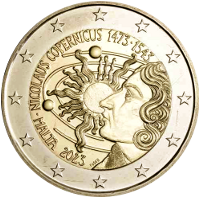 🔎
🔎 |
 |
Malta | 14 Sep. 2023 | 550th anniversary of the birthday of Nicolaus Copernicus |
20003 20005 20009 |
90,500 |  |
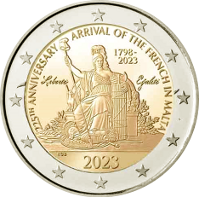 🔎
🔎 |
 |
Malta | 14 Sep. 2023 | 225th anniversary of the arrival of the French in Malta |
20003 20005 |
80,500 |  |
 Work in progress |
|||||||
| References : | |||
| 20001 | Images taken with authorisation by the ECB ‐ Mail dated 20.Feb.2020 © "European Central Bank" |
20002 | Data mirrored from Wikipedia Page "2_euro_commemorative_coins" with friendly support of the guardians of that page. |
| 20003 | Images taken with authorisation by H....... Hamburg | 20004 | Coloured version of this Commemorative Coin in circulation EU‐legal‐technical specifications do not recongnise colour prints. The EU nevertheless tolerates them, as their numbers are very small and they are sold in special packs and therefor are very unlikely to be used as currency. |
| 20005 |
enlarged Images taken with authorisation by Gerd Seyffert © "Gerd Seyffert 2021" |
20006 | Not Applicable |
| 20007 | Images taken by Münzen Kreuzberg © "Münzen Kreuzberg 2021" |
20008 | enlarged Images taken by Münzen Kreuzberg © "Münzen Kreuzberg 2021" |
| 20009 | Text with kind permission by Gerd Seyffert © "Gerd Seyffert 2023" |
20010 | Not Applicable |
 |

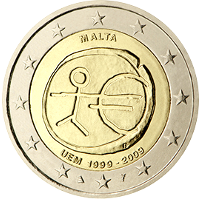



 )
is minted here.
)
is minted here.